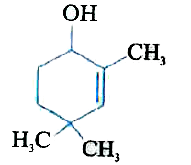Describe the acton of aqueous KOH (or NaOH) on ethyl bromide .
To describe the action of aqueous KOH (or NaOH) on ethyl bromide, we will follow these steps:
Step 1: Identify the Reactants
The reactants in this reaction are ethyl bromide (C2H5Br) and the aqueous base (KOH or NaOH). Ethyl bromide is a primary alkyl halide.
Step 2: Understand the Structure of Ethyl Bromide
Ethyl bromide has the structure:
- C2H5Br (or CH3-CH2-Br)
This means it consists of an ethyl group (C2H5) attached to a bromine atom (Br).
Step 3: Mechanism of Reaction
The reaction mechanism involves nucleophilic substitution. The hydroxide ion (OH-) from KOH or NaOH acts as a nucleophile.
1. Nucleophilic Attack: The negatively charged hydroxide ion (OH-) attacks the electron-deficient carbon atom that is bonded to the bromine atom. This is due to the electronegativity of bromine, which creates a partial positive charge on the carbon.
2. Leaving Group: As the hydroxide ion attacks, the bromine atom (Br) leaves as a bromide ion (Br-).
Step 4: Type of Reaction
This reaction is classified as an SN2 (bimolecular nucleophilic substitution) reaction because:
- Ethyl bromide is a primary halide, which allows for a less hindered pathway for the nucleophile to attack.
- The reaction occurs in a single step where the nucleophile attacks and the leaving group departs simultaneously.
Step 5: Products of the Reaction
The main product of the reaction is ethanol (C2H5OH), and the by-product will be either potassium bromide (KBr) or sodium bromide (NaBr), depending on whether KOH or NaOH is used.
- With KOH:
- Main Product: Ethanol (C2H5OH)
- By-product: Potassium bromide (KBr)
- With NaOH:
- Main Product: Ethanol (C2H5OH)
- By-product: Sodium bromide (NaBr)
Summary of the Reaction
The overall reaction can be summarized as follows:
1. With KOH:
C2H5Br+KOH→C2H5OH+KBr
2. With NaOH:
C2H5Br+NaOH→C2H5OH+NaBr
Final Answer
The action of aqueous KOH or NaOH on ethyl bromide results in the formation of ethanol as the main product, along with potassium bromide or sodium bromide as by-products.
---
The reactants in this reaction are ethyl bromide (C2H5Br) and the aqueous base (KOH or NaOH). Ethyl bromide is a primary alkyl halide.
Ethyl bromide has the structure:
- C2H5Br (or CH3-CH2-Br)
This means it consists of an ethyl group (C2H5) attached to a bromine atom (Br).
The reaction mechanism involves nucleophilic substitution. The hydroxide ion (OH-) from KOH or NaOH acts as a nucleophile.
2. Leaving Group: As the hydroxide ion attacks, the bromine atom (Br) leaves as a bromide ion (Br-).
This reaction is classified as an SN2 (bimolecular nucleophilic substitution) reaction because:
- Ethyl bromide is a primary halide, which allows for a less hindered pathway for the nucleophile to attack.
- The reaction occurs in a single step where the nucleophile attacks and the leaving group departs simultaneously.
The main product of the reaction is ethanol (C2H5OH), and the by-product will be either potassium bromide (KBr) or sodium bromide (NaBr), depending on whether KOH or NaOH is used.
- Main Product: Ethanol (C2H5OH)
- By-product: Potassium bromide (KBr)
- Main Product: Ethanol (C2H5OH)
- By-product: Sodium bromide (NaBr)
The overall reaction can be summarized as follows:
C2H5Br+KOH→C2H5OH+KBr
C2H5Br+NaOH→C2H5OH+NaBr
The action of aqueous KOH or NaOH on ethyl bromide results in the formation of ethanol as the main product, along with potassium bromide or sodium bromide as by-products.
Similar Questions
Knowledge Check
 on treatment with aqueous KOHA
on treatment with aqueous KOHA B
B C
C D
D
Assertion: In the reaction of tert-butyl bromide with aq. KOH, rate becomes double by increasing the concentration of both aq. KOH and tert-butyl bromide
Reason: Rate of reaction is, rate = kſtert butyl bromide) [OH−].AAssertion and reason both are correct statements and reason is correct explanation for assertion.BAssertion and reason both are correct statements but reason is not correct explanation for assertion.CAssertion is correct statement but reason is wrong statement.DAssertion is wrong statement but reason is correct statement.Assertion: In the reaction of tert-butyl bromide with aq. KOH, rate becomes double by increasing the concentration of both aq. KOH and tert-butyl bromide
Reason: Rate of reaction is, rate = kſtert butyl bromide) [OH−].AAssertion and reason both are correct statements and reason is correct explanation for assertion.BAssertion and reason both are correct statements but reason is not correct explanation for assertion.CAssertion is correct statement but reason is wrong statement.DAssertion is wrong statement but reason is correct statement.
What happens when : (i) Ethyl chloride is treated with aqueous KOH ?
(ii) Methyl bromide is treated with sodium in the presence of dry ether?
View SolutionWhat happens when
(i) n-butyl chloride is treated with alcoholic KOH,
(ii) bromobenzene is treated with Mg in the presence of dry ether,
(iii) chlorobenzene is subjected to hydrolysis,
(iv) ethyl chloride is treated with aqueous KOH,
(v) methyl bromide is treated with sodium in the presence of dry ether,
(vi) methyl chloride is treated with KCN?
View SolutionExplain , the mechanism of alkaline hydrolysis (reaction with aqueous KOH) of tert-butyl bromide (2-Bromo-2- methyl - propane ) with energy profile diagram.
View SolutionDescribe the action of AgCN on ethyl bromide.
View SolutionDescribe the action of alcoholic potassium hydroxide (alc. KOH) on n-propyl bromide.
View Solution
